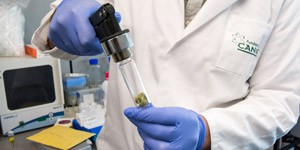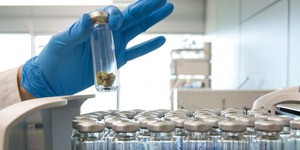By Raquel Peyraube

Dr. Raquel Peyraube is a doctor in medicine and a specialist in the problematic use of drugs. She has trained in psychiatry, toxicology and psychoanalytical psychotherapy and in subjects such as childhood, adolescence and social exclusion. She has 28 years' experience in the field. Throughout her career, she has made contributions in training, prevention, treatment and damage reduction, including innovating theoretical and methodological developments with emphasis on ethical issues. As a former clinical director of ICEERS, she is now an ad hoc consultant of the Uruguayan National Drugs Secretariat giving advice on reform of the public drugs policy and of the Institute of Cannabis Regulation and Control. She is a clinical researcher and a member of research teams for monitoring the law in Uruguay. She sits on several international scientific committees and is an active member of the IACM (International Association for Cannabinoid Medicines). She currently works on the development of clinical trials, medical education on medicinal cannabis, and dissemination of information and advice for reform of drugs policies in various countries.
In the second part of our article, we shall be discussing some of the health effects of cannabis that tend to cause greatest concern. Clinical practice, observational studies and clinical trials with medicinal cannabis have shown that these harmful effects do not always present. Whether they occur depends on usage, the patient’s prior background, and on the type and dose of the cannabinoids.
This is the case with chemical dependency (CD). Cannabis has been estimated to have an addictive potential of 9% (which incidentally, is considerably lower than the rate for any other psychoactive substance including many drugs widely used in psychiatric therapy, such as benzodiazepines). Development of cannabis dependency has only been verifiably demonstrated almost exclusively amongst adult users. However it is almost never found in people using the drug for medicinal purposes and even less so if treatment is properly performed – even when the preparations contain THC, the cannabinoid believed to be responsible for chemical dependency. Generally, in such cases, patients normally do not increase their dose to achieve the same effect as a result of tolerance (the basis for the phenomenon of dependency). Moreover, as their symptoms improve, they tend to reduce their usage or give it up altogether, with no clinical signs of withdrawal syndrome. The same is not true of opiates and benzodiazepines.
I would therefore like to take this chance to call for a wider debate on the disproportionate importance that tends to be given to the subject of CD in the context of medical cannabis use. In general, use of cannabinoids (like opiates) tends to be restricted to serious pathologies which cause major suffering and distress for patients and their families. There appears to be a strong intolerance of chemical dependence on psychotropic substances in our culture, even in the context of disease. While not seeking to trivialise the importance of chemical dependency, it is important to consider the relative costs and benefits.
We should also discuss cannabis’s identification as a “gateway” drug, leading to consumption of more dangerous drugs. Although the phenomenon of generalisation of consumption or drug association exists in pharmacological terms, the number of people who have consumed cannabis and then gone on to use other drugs, is much lower than those who have not. Secondly, it is true that many people who consume cocaine, heroin, methamphetamines and other drugs previously consumed cannabis, generally in the form of marijuana (ground flowers or leaves); however, in the vast majority of cases, their initiation to other types of drug was unrelated to the effects of cannabis, and was instead caused by what has been called the “gondola effect” (so called because of the supermarket shop display unit) involving the superimposition of different drug markets. Sometimes you might go to the supermarket with a shopping list, but end up being tempted by special offers to make other unplanned purchases. Similarly, when cannabis users go to buy the drug, they are sometimes offered other items and so start to experiment with other more addictive substances. This has been empirically demonstrated in the Netherlands where the introduction of ‘coffee shops’ led to a separation of markets. Whereas in countries with overlapping markets, the peak age of users of cocaine, amphetamines, heroine, etc. stands at around 22-25, in the Netherlands the figure is 38. In other words, the population of users is older because there are fewer new cases joining their ranks.
Then prevalence of this belief is also due to the misuse of statistics from surveys carried out in drug treatment centres on a population with problematic poly-drug use, where the results have been extrapolated to all users. In this way, a partial truth has been fallaciously extended to the entire population of cannabis users. The immense majority of cannabis users do not present problematic use, do not use other drugs and are not in treatment. These studies therefore have no statistical value. In order to state that cannabis leads to the consumption of other substances per se, the study would have to have been performed on the general population of users of all drugs, including tobacco and alcohol, which are the most frequent antecedents of drug consumption.
Finally, there are certain individuals with a sort of voracious appetite for chemicals who search for and consume all kinds of substances that might alter their consciousness or give them some sort of “hit”. Their conduct is that of active seekers and they explore the drug world looking to find new chemical sensations, even though they may have a specific drug of choice. This is what is known as chemophilia. Obviously such individuals have also used cannabis.
There is an increasing body of evidence from clinical trials and preclinical studies to suggest that quite the opposite may be true: rather than being a gateway drug, cannabis might be an ‘exit drug’. Authors such as A. Reiman and P. Lucas talk about the ‘substitution effect’, and have demonstrated in observational studies that in more than 50% of people with chemical dependence on alcohol, cocaine, heroin and tobacco, consumption of these drugs was either eliminated or reduced when replaced with cannabis. Throughout my practice I have observed for myself this effect and its medical potential in addictive disorders. I believe it should be the subject of clinical trials to assess that potential using scientific criteria. Together with JC. Bouso (as principal co-researcher) and another six researchers from different disciplines in the School of Medicine of Uruguay, I have designed a clinical protocol for this purpose which has already been approved by the ethics committee. We are now awaiting authorisation from the health authorities and financing before conducting trials.
Another effect that has been widely discussed and used as an argument against authorisation is the relationship between cannabis use and the generation of depression and schizophrenic psychosis. In the case of schizophrenia, although the controversy persists, with publications supporting one thesis or another, the epidemiological evidence suggests that there is no such link: although cannabis consumption rates have increased very considerably, rates of schizophrenia have not, remaining at between 1-2% in different cultures and countries. If there were a causal relationship, these figures should also have increased.
The risk of such harmful effects cannot be established in a linear cause-and-effect relationship. It depends on the underlying psychopathological structure of the individual user, in other words on their prior vulnerability. However, there are at least two other additional factors that need to be taken into consideration: the age at which the subject initiates consumption and the composition of the substance in question.
Cannabis could be a trigger factor: the young person may already have a predisposition which will present at some moment in their life, but early initiation in cannabis use would show it up earlier. This action would be due to the psychotomimetic effect of THC-containing cannabis. The same is not true of CBD, which has antipsychotic effects and is antagonistic to the psychodysleptic effect of THC. There are some very interesting studies showing that CBD corrects the alterations caused by THC.
An assessment should be made with public health criteria as to whether there has been an increase in the prevalence of acute psychotic cases related to the use of cannabis. Schizophrenia is a chronic psychosis; that is to say, it will last throughout the lifetime of the subject. The acute psychoses to which I am referring are sudden-onset disorders which last for a short period and are reversible within a space of hours or days and are secondary to consumption. They are characterised by massive anxiety and angst, self-reference and sometimes persecutory elements with a marked delusional component. In rare cases, they may even be accompanied by hallucinations.
These effects also depend on the type of use, the kind of cannabinoid and the dose. A study of cannabidiol evidences its antipsychotic effect, at least as a coadjuvant to treatment, without the side effects of conventional medication. Clinical trials are required.
The same is not true of THC, which should be avoided or used only with extreme precaution by people with personality structures with a tendency or family history of psychosis, with varieties or preparations that have low concentrations of THC and high levels of CBD.
In cases of depression, some patients benefit from additional use of cannabis preparations, but others show signs of depression. Although there is some interesting evidence, such as for example that it improves sleep among such cases and in patients with anxiety depression disorders, there is still insufficient knowledge to allow its use to be systematised with clear parameters on dose, type of depression, etc. Future scientific research must therefore determine the safety and effectiveness of such applications and the conditions of use under which benefits can be obtained. In my clinical experience, symptoms of depression associated with chronic diseases such as Parkinson's can be improved with the use of cannabinoids. Although one can presume that its antidepressant effect has contributed to an improvement in the patient's mood, we cannot be categorically certain of this, since it may also be due to an improvement in their symptoms and quality of life.
Panic attacks may also be linked to a pre-existing vulnerability, but the patient's mood before using THC (fear, sorrow, etc.) may also play a role. CBD and some natural varieties that almost exclusively contain this cannabinoid can be used to treat anxiety disorders. These symptoms may also occur in habitual cannabis users who on a given occasion have consumed higher doses of THC or combined it with other drugs (poly-drug consumption).
Cannabis use has been said to produce cancer. The two most important cannabinoids in the plant have already been shown to have antitumour and antimetastatic actions for many types of tumour, and the mechanisms through which these effects occur have been clearly identified by researchers such as M. Guzmán, C. Sánchez and M. Nabissi among others. These mechanisms include death of tumour cells by apoptosis, inhibition of the angiogenic factor (the factor which promotes development of vessels in the tumour), and the cell migration factor. Basic, preclinical and observational research studies now exist indicating that in the future these compounds might be used as antitumor agents. However, very few clinical trials have been conducted assessing their efficacy. On the other hand, studies have shown that when associated with chemotherapy it improves the results of the therapy.
What can cause cancer is when it is smoked, like any other organic substance consumed by way of incomplete combustion. Some studies have shown that people who smoke cannabis to an intense degree often suffer from chronic bronchitis. However, they do not appear to have a greater incidence of cancer than non-cannabis users. It is therefore recommended that there be a move towards vaping instead of smoking, in order to reduce the associated risks. I hope that this change will be embraced by cannabis users and that new generations will initiate use with these forms of consumption.
Cannabis can affect concentration, IQ and short-term memory, depending on the composition, quantity and frequency of use. Even after prolonged use, these alterations are usually reversed when usage ceases. When consumed occasionally and at low doses, the effect is limited to the time of use and is only partial. In general, medical users do not report these adverse effects and where they do present, they can be alleviated simply by reducing the dose.
As for the effects on motor coordination and the ability to drive, clearly, under no circumstances should anyone drive whilst under the effects of cannabis or any other psychoactive substance. However, it is interesting to analyse this phenomenon, given that unlike concentration and memory, a compensation for the effect on motor coordination develops amongst chronic users, whereas those who use it more occasionally present these alterations under the effects of the drug. This does not mean that it should be used frequently to foster habituation; on the contrary, on health grounds, it should be used at spaces of time and subjects should not drive or use machinery. It is worth noting one major difference between the effects of cannabis and those of alcohol and cocaine. The latter, as well as causing a state of exaltation, create a tendency to irritability, lack of self-criticism and feeling of omnipotence, with the result that users tend to drive recklessly without due care for themselves and others. Apart from the fact that the "trip" is completely different, providing cannabis users are not having a bad trip or experiencing acute psychotic symptoms, they do not lose their awareness of being under its effects. Nonetheless, it is important to be very clear that this is no justification for its use in situations that might pose a risk for the subject or others.
In addition to the above, use of cannabinoids may be accompanied by non-serious adverse effects: tiredness, sedation and drowsiness, dizziness, tachycardia , hypo- or hyper-tension, orthostatic hypotension, dry mouth, reduced lacrimation, muscle relaxation, increased appetite and bloodshot eyes.
Not a single case has been recorded of a lethal overdose resulting exclusively from cannabis.
It is important to note that cannabinoids have a bimodal effect. This means that one dose can have one effect and another can have the opposite.
One side effect which should be taken into account, given its possible consequences, is hypoglycaemia, which if very pronounced can lead to severe dizziness, loss of consciousness and falling. It is important to always have sweets or glucose-rich food to hand to reverse the situation rapidly.
As for cardiovascular effects, special care should be taken by people with cardiovascular disorders and cannabis users who mix it with cocaine and its derivatives, since the risk of heart failure, arrhythmia or infarction increases when the effect on heart rate is boosted. The subjective feeling of well-being caused by simultaneous use does not reflect the real effect on the body’s organs and systems.
Indisputably, strict precautions should be taken amongst pregnant women, children, adolescents, the elderly and people with cardiovascular problems. However, in my opinion these are not absolute contraindications of medicinal use, but should depend on the cannabinoids used and the seriousness of the symptoms being treated. For example, treatment of children with epilepsy and autistic spectrum disorder using CBD and in some cases also added THC is well documented.
For all of these reasons, the adverse effects of cannabis use should be weighed up, taking into account the patient and the clinical situation, the context of usage, the type of cannabinoid and the dose.


